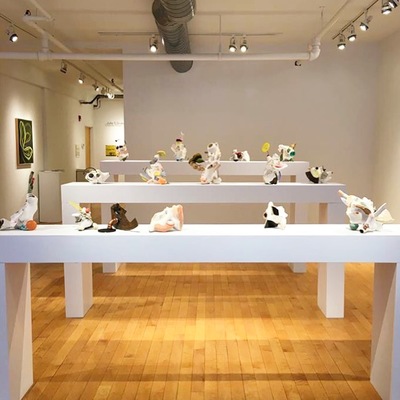A Hole Other World: Linda Leslie Brown’s “More Holes”

View of “Linda Leslie Brown: More Holes.” Photo: Ann Wessman.
By Olivia J. Kiers
As soon as you enter the Kingston Gallery, Linda Leslie Brown’s recent, whimsical mixed-media sculptures not only catch your eye, they seem to return your gaze. Ranged on a series of high benches that rise like bleachers from the middle of the gallery floor, Linda Leslie Brown: More Holes is an exhibition that confounds expectations. Part of the viewing experience is shaped by the unusual arrangement of the show. By eschewing the plinth as a support, More Holes organizes rather than presents its objects in a manner that is more evocative of the tiered vitrines of a natural history museum than a gallery show. Yet, these are unclassifiable objects, and organizational systems seem pointless when confronted with their mutable nature. Indeed, this is one exhibition that raises more questions than it answers, and that is the genius behind Brown’s sculpture.

Linda Leslie Brown, “Topiary,” 2015, mixed media, photo courtesy the artist.
The first question that arises is What are these sculptures made from? Brown works with found materials plastered into lumps that resemble chunks of coral, concrete aggregate gone wrong, or even miniature worlds full of boulders and caves, and weird, plastic trees. Rippled fragments of shell emerge alongside a corner of a submerged flashlight or a doll’s elbow. The doll limbs, especially, appear throughout the series. Brown’s interest in ceramic doll parts relates to the “creaturely character” with which they imbue her sculptures. “I’m interested in those figural, tubal transitions that lead from one place to another,” she explains. “There’s an armpit and back-of-the-knee quality to a lot of the work.”

Linda Leslie Brown, “Odd Jobs,” 2016, mixed media, photo courtesy the artist.
This leads to the second question: What do these sculptures represent? The titles of these works offer intriguing possibilities. Despite figural tendencies, some veer towards a constructed environment. For example, one piece containing clumps of fake moss is titled Topiary with reassuringly straightforward logic. Yet the most intriguing works—Announcement, Fashion Week or Odd Jobs—are all ambivalent objects, to be explored almost as much by the intellect and imagination as the eye. As the exhibition’s curator, Kingston Gallery director Shana Dumont Garr, states in her introductory essay, “Despite their small size, it is impossible to summarize each work from a single point of view. Like unearthed, archaeological treasures, a key part of the sculptures’ strengths lies in their inscrutability.”
Inscrutable, Brown’s work is also uniquely explorable. More Holes is an invitation to peek into the nooks and crannies of each enigma, not in order to solve any mystery, but precisely to get wonderfully lost, slipping in through one hole and out from another.
Linda Leslie Brown: More Holes is on view at the Kingston Gallery in Boston through May 29.
